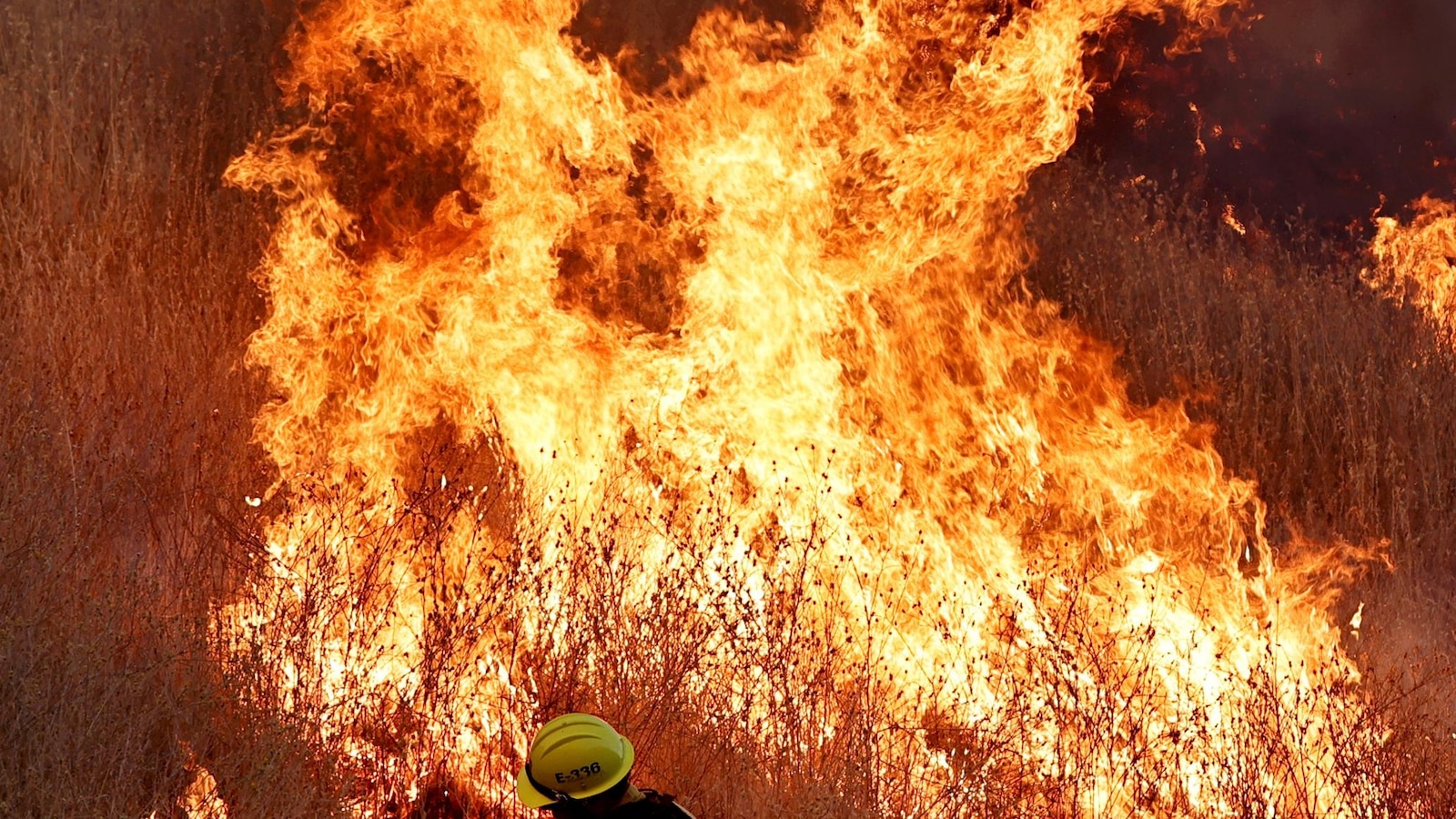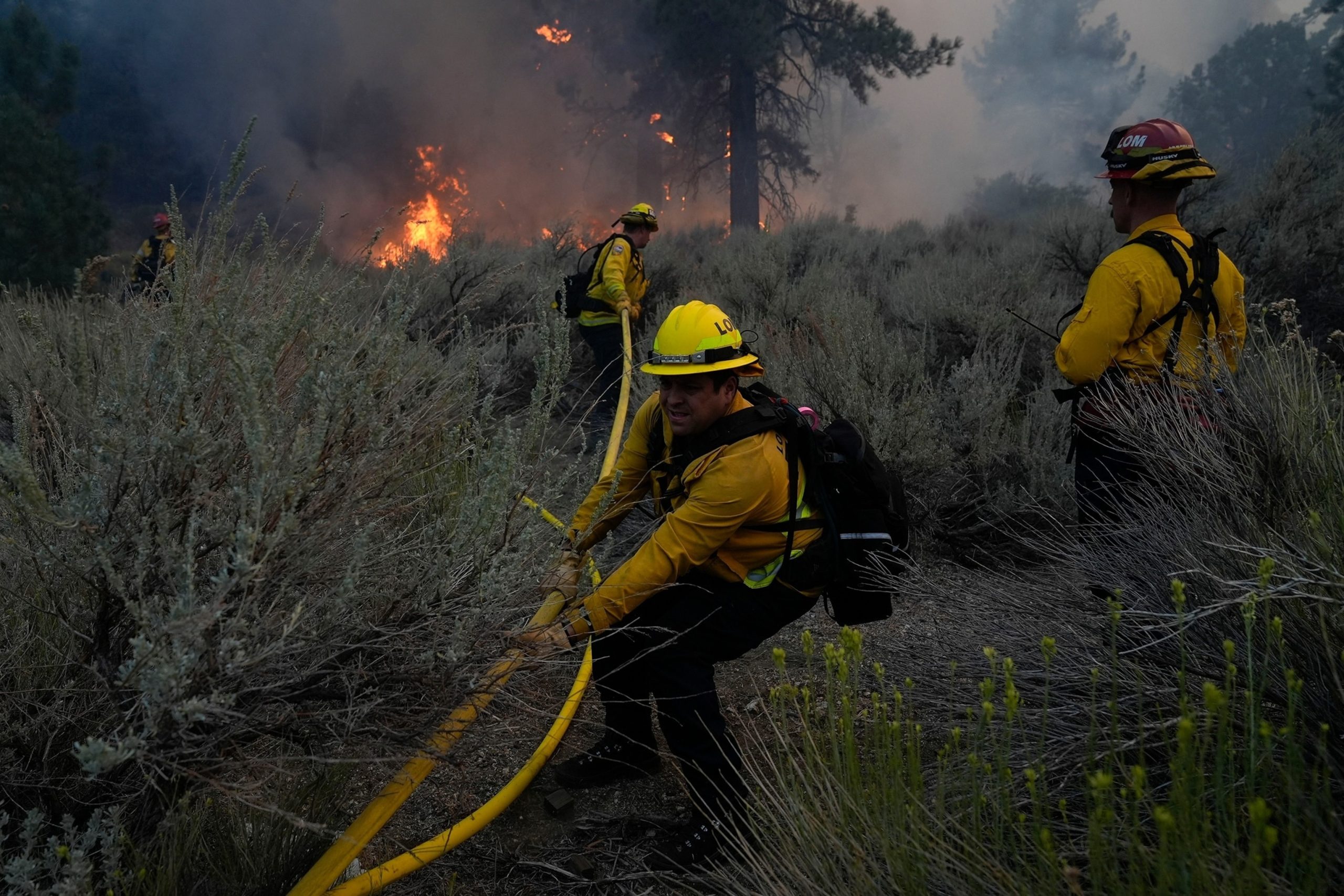
RIVERSIDE, Calif. — Three homes lay in ruins Monday after one of many dangerous wildfires in the West suddenly swept into a Southern California neighborhood during a blistering heat wave.
The homes were ravaged when the fire erupted Sunday afternoon in a hilly area of Riverside, a city about 60 miles (95 kilometers) east of Los Angeles. Four other structures were damaged, Riverside Deputy Fire Chief Steve McKinster said.
The cause of the fire, which had scorched just under a square mile (2.6 square kilometers), was under investigation.
Resident Noel Piri and his wife were away when they got a call about a fire in the neighborhood, rushed home and rescued their dog. Unfortunately, their house was in flames when firefighters arrived, The Press-Enterprise reported.
“It was kind of sad to see the house was gone,” Piri told the newspaper after rummaging through the remains of the newly remodeled house.
Riverside hit 102 degrees (38.9 Celsius) on Sunday amid a heat wave that has been largely focused on the interior of California and is expected to last through much of the week.
Many other fires were also burning throughout the state, including one that started Saturday and rapidly expanded to more than 4 square miles (10.3 square kilometers) on the border of Lake and Colusa counties, northwest of Sacramento. Containment reached 25% on Monday.
More than two dozen fires were burning in the Pacific Northwest and Idaho, where lightning ignited more blazes in Oregon over the weekend amid extremely dry and hot conditions. The largest blazes were active in rural areas of eastern Oregon and Washington, where smoke impacted air quality.
Authorities evacuated the town of Huntington, Oregon, with a population of about 500, and closed a stretch of Interstate 84 late Sunday after thunderstorms caused a massive smoke column to collapse.
The implosion of the plume sent winds of 50 mph (80 kph) in every direction, raising fears the fire would jump I-84, the Baker County Sheriff’s Office said in a Facebook post announcing the “go now” evacuations.
By Monday, I-84 had reopened and the town was still safe, but evacuation orders remained in place and extreme fire behavior was expected again, authorities said. The fire covered more than 272 square miles (704 square kilometers) with no containment.
Large wildfires can generate huge plumes of smoke and ash that can rise more than 5 miles (8 kilometers), depending on conditions such as the terrain, weather and temperature. The columns can collapse when the amount of heat over the fire drops — from changing fuels or weather — and reduces the updraft, or when strong winds sheer off the top of the column.
In the most extreme cases, smoke columns can be topped with “fire clouds,” or pyrocumulus clouds, that look much like the thunderheads that develop before a big thunderstorm.
It’s not unusual for a smoke column to collapse, and some fires go through multiple cycles of column collapse and regeneration in a day, according to the Southwest Fire Science Consortium.
Authorities in Utah, meanwhile, lifted evacuation orders for a wildfire in Salt Lake City that threatened neighborhoods near the state Capitol over the weekend.
The blaze began Saturday and grew to about 200 acres (80 hectares). The evacuation order was lifted late Sunday, but officials cautioned that residents needed to remain ready to evacuate, with the fire only partially under control as of Monday morning.
Wildfires in the Western United States have been a growing concern in recent years, with the region experiencing larger and more destructive fires than ever before. This year, the situation has been exacerbated by an extreme heat wave that has gripped much of the West, creating conditions that are ripe for wildfires to spread rapidly and uncontrollably.
The heat wave, which has brought record-breaking temperatures to states like California, Oregon, and Washington, has dried out vegetation and soil, making them more susceptible to ignition. In addition, the high temperatures have also increased the likelihood of lightning strikes, which can spark fires in remote areas that are difficult for firefighters to access.
The combination of extreme heat and dry conditions has led to a surge in wildfire activity across the West. In California alone, there have been over 6,000 wildfires so far this year, burning more than 1.2 million acres of land. In Oregon, the Bootleg Fire has become one of the largest wildfires in the state’s history, scorching over 400,000 acres and forcing thousands of residents to evacuate their homes.
The impact of these wildfires extends beyond just the destruction of land and property. The smoke from the fires can also pose serious health risks to residents in affected areas, especially those with respiratory conditions. In addition, the fires can have long-lasting environmental consequences, including the destruction of habitats for wildlife and the release of carbon dioxide into the atmosphere, contributing to climate change.
Efforts to combat these wildfires have been hampered by the extreme heat and challenging terrain. Firefighters are working around the clock to contain the blazes, but their efforts are often hindered by the unpredictable nature of wildfires and the difficult conditions they face on the front lines.
As climate change continues to worsen, experts warn that wildfires in the West are likely to become more frequent and more severe. It is crucial that policymakers take action to address the root causes of these fires, including reducing greenhouse gas emissions and implementing measures to prevent wildfires from spreading out of control.
In the meantime, residents in wildfire-prone areas should take precautions to protect themselves and their property. This includes creating defensible space around homes, having an evacuation plan in place, and staying informed about fire conditions in their area.
Ultimately, the combination of extreme heat waves and wildfires in the West is a stark reminder of the urgent need to address climate change and its devastating impacts on our environment and communities. Only through collective action and a commitment to sustainability can we hope to mitigate the effects of these disasters in the future.


